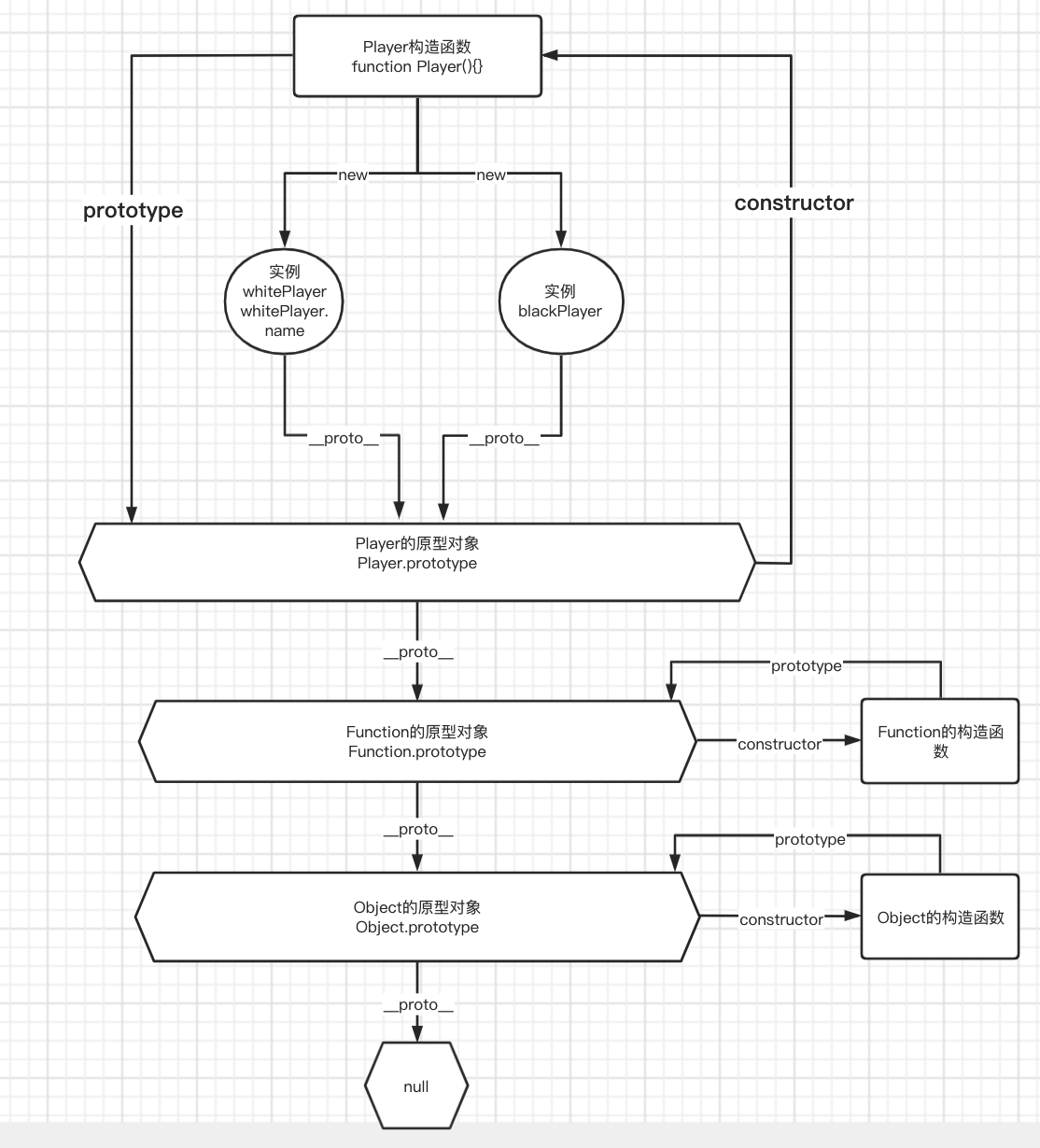原型及原型链
# 原型及原型链
# 在原型上添加属性或者方法有什么好处?
刚才已经说过了,如果不通过原型的方式,每生成一个新对象,都会在内存中新开辟一块存储空间,当对象变多之后,性能会变得很差。
但是通过
Player.prototype.xx = function () {};
Player.prototype.xx = function () {};
Player.prototype.xx = function () {};
这种方式向原型对象添加属性或者方法的话,又显得非常麻烦。所以我们可以这样写
Player.prototype = {
start: function () {
console.log("下棋");
},
revert: function () {
console.log("悔棋");
},
};
# 怎么找到 Player 的原型对象?
function Player(color) {
this.color = color;
}
Player.prototype.start = function () {
console.log(color + "下棋");
};
const whitePlayer = new Player("white");
const blackPlayer = new Player("black");
console.log(blackPlayer.__proto__); // Player {}
console.log(Object.getPrototypeOf(blackPlayer)); // Player {},可以通过Object.getPrototypeOf来获取__proto__
console.log(Player.prototype); // Player {}
console.log(Player.__proto__); // [Function]
可以看一下 prototype.png 原型的流程图

# 那么 new 关键字做了什么就很明了了
- 一个继承自 Player.prototype 的新对象 whitePlayer 被创建
- whitePlayer.proto 指向 Player.prototype,即 whitePlayer.proto = Player.prototype
- 将 this 指向新创建的对象 whitePlayer
- 返回新对象 4.1 如果构造函数没有显式返回值,则返回 this 4.2 如果构造函数有显式返回值,是基本类型,比如 number,string,boolean, 那么还是返回 this 4.3 如果构造函数有显式返回值,是对象类型,比如{ a: 1 }, 则返回这个对象{ a: 1 }
后面看一下怎么手写实现 new 函数
// 1. 用new Object() 的方式新建了一个对象 obj
// 2. 取出第一个参数,就是我们要传入的构造函数。此外因为 shift 会修改原数组,所以 arguments 会被去除第一个参数
// 3. 将 obj 的原型指向构造函数,这样 obj 就可以访问到构造函数原型中的属性
// 4. 使用 apply,改变构造函数 this 的指向到新建的对象,这样 obj 就可以访问到构造函数中的属性
// 5. 返回 obj
function objectFactory() {
let obj = new Object();
let Constructor = [].shift.call(arguments);
obj.__proto__ = Constructor.prototype;
let ret = Constructor.apply(obj, arguments);
return typeof ret === "object" ? ret : obj;
}
# 原型链又是什么呢?
我们都知道当读取实例的属性时,如果找不到,就会查找与对象关联的原型中的属性,如果还查不到,就去找原型的原型,一直找到最顶层为止。
举个例子
function Player() {}
Player.prototype.name = "Kevin";
var p1 = new Player();
p1.name = "Daisy";
// 查找p1对象中的name属性,因为上面添加了name,所以会输出“Daisy”
console.log(p1.name); // Daisy
delete p1.name;
// 删除了p1.name,然后查找p1发现没有name属性,就会从p1的原型p1.__proto__中去找,也就是Player.prototype,然后找到了name,输出"Kevin"
console.log(p1.name); // Kevin
那如果我们在 Player.prototype 中也找不到 name 属性呢,那么就会去 Player.prototype.proto中去寻找。
Object.prototype.name = "root";
function Player() {}
Player.prototype.name = "Kevin";
var p1 = new Player();
p1.name = "Daisy";
// 查找p1对象中的name属性,因为上面添加了name,所以会输出“Daisy”
console.log(p1.name); // Daisy
delete p1.name;
// 删除了p1.name,然后查找p1发现没有name属性,就会从p1的原型p1.__proto__中去找,也就是Player.prototype,然后找到了name,输出"Kevin"
console.log(p1.name); // Kevin
delete Player.prototype.name;
console.log(p1.name);
这样一条通过proto和 prototype 去连接的对象的链条,就是原型链